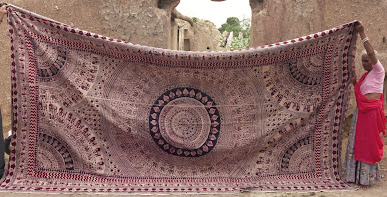In the state of Rajasthan in northern India, a traditional use of block printing is the making of jajam floor spreads. Jajam are large cotton textiles that look to my eye like heavy bedspreads or tablecloths, but their use is right there in the name: Jajam means “coming together, gathering” and their use was to spread out on the floor for people to sit on, in a whole variety of social gatherings. They were used for weddings, festivals, village council meetings, and all sorts of social events, and a jajam might be owned by a family, a temple, or communally owned by multiple families or an entire village. A jajam might be included as part of a dowry, might be custom made to fit a particular courtyard or floor space, or might be given as an offering to a temple. Clearly they speak to a community-oriented village life which
began to disappear in the mid-20th century when many people migrated to cities and the traditional ways of village life began to erode. With the erosion of the village traditions, the physical craft of printing jajam also began to disappear. Luckily, there are some people celebrating the craft, preserving traditional jajam, and promoting new work for those artists who still practice the skills of the art.
I’m looking at this primarily from a block printing perspective, so here are some of the things I find coolest about jajam as a printmaking medium. For one thing, the designs are printed with carved teak wood blocks, which I understand, but it seems that these blocks are in some way packed with wool scraps, which I do not understand. It seems to have something to do with making the block absorb ink. In addition to printing with ink, the designs may
also be printed with mud as a resist, and then the whole cloth dyed, leaving the printed areas un-dyed. The most common traditional colors are red and black (and the cream of the fabric). I also learned that the printing is done on tables padded with multiple layers of cotton, which makes sense for getting a good, solid impression. The designs are largely geometric, with multiple borders surrounding a patterned central area. The borders may include botanical motifs, animals, and people, as well as geometric designs, and apparently borders of fierce things such as tigers, elephants, and warriors are thought to symbolize protection of all the people sitting on the jajam within the border.
Perhaps my favorite thing of all is that the center of a jajam frequently includes a printed chaupad game board, which is in a cross shape. Chaupad is related to pachisi, and I love the thought that it might be played not only at a family gathering, but perhaps as a break in the middle of a long village council meeting, too!
As you can imagine, a fabric that people are sitting and walking on takes a lot of wear, and it seems that there are not a lot of very old samples of jajam still surviving. I wish I could have found more pictures, and of course I really wish I could magically visit the Anokhi Museum in Jaipur, which is in collaboration with the Wabisabi Project, my main source of information for this blog post.
I think this is the perfect time to revive an art form that celebrates people sitting around together playing board games, although unfortunately we still need to wait a little longer before we gather the whole village together on one jajam. Maybe we’d better block print some fabric for masks, too, while we’re at it.
[Pictures: Jajam from Marwar region, printed by Usman Alarakha Chhipa, c 1960 (Image from Wabisabi Project);
Detail of traditional syahi-begar jajam, printed by Devi Sahay Chhipa, c 1997 (Image from Anokhi Museum);
Block with motifs inspired by architecture, carved by Abdul Sattar Kharadi;
Stuffing wool into a block (namda), by Rashid Ahmed (Images from Wabisabi Project);
Printing a block (no specific information) (Images from Wabisabi Project documentary trailer);
Printing a large jajam (no specific information) (Image from Wabisabi Project);
Jajam from Ajmer region, printed by Kanniyalal Chhipa, c 1958 (Image from Wabisabi Project);
Children sitting on a jajam (no specific information) (Image from Wabisabi Project).]
By the way, chhipa means “wood block carver”!







4 comments:
I'd never heard of this before, but I am absolutely in love with the idea. May the tradition of the jajam live on!
Yeah, to me it feels like a picnic every time you meet! I imagine it isn't that frivolous to the people who traditionally used jajam, but it seems like a wonderful community thing.
जाजम कहा पर मिलेगी
Sorry, Anon, I'm not a dealer or anything. I don't know where one can get a jajam.
Post a Comment